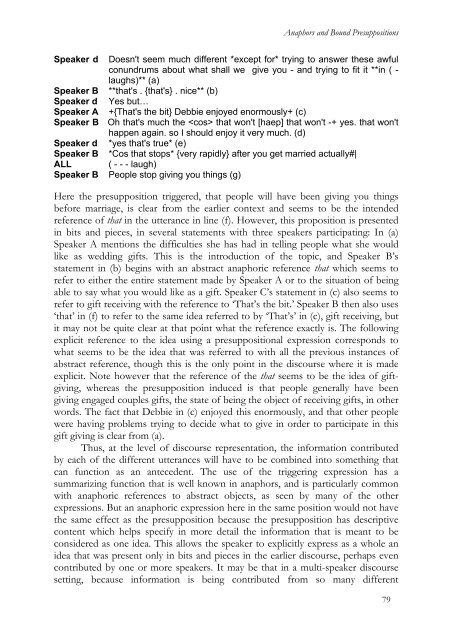Presuppositions in Spoken Discourse
Presuppositions in Spoken Discourse
Presuppositions in Spoken Discourse
You also want an ePaper? Increase the reach of your titles
YUMPU automatically turns print PDFs into web optimized ePapers that Google loves.
Anaphors and Bound <strong>Presuppositions</strong><br />
Speaker d Doesn't seem much different *except for* try<strong>in</strong>g to answer these awful<br />
conundrums about what shall we give you - and try<strong>in</strong>g to fit it **<strong>in</strong> ( -<br />
laughs)** (a)<br />
Speaker B **that's . {that's} . nice** (b)<br />
Speaker d Yes but…<br />
Speaker A +{That's the bit} Debbie enjoyed enormously+ (c)<br />
Speaker B Oh that's much the that won't [haep] that won't -+ yes. that won't<br />
happen aga<strong>in</strong>. so I should enjoy it very much. (d)<br />
Speaker d *yes that's true* (e)<br />
Speaker B *Cos that stops* {very rapidly} after you get married actually#|<br />
ALL ( - - - laugh)<br />
Speaker B People stop giv<strong>in</strong>g you th<strong>in</strong>gs (g)<br />
Here the presupposition triggered, that people will have been giv<strong>in</strong>g you th<strong>in</strong>gs<br />
before marriage, is clear from the earlier context and seems to be the <strong>in</strong>tended<br />
reference of that <strong>in</strong> the utterance <strong>in</strong> l<strong>in</strong>e (f). However, this proposition is presented<br />
<strong>in</strong> bits and pieces, <strong>in</strong> several statements with three speakers participat<strong>in</strong>g: In (a)<br />
Speaker A mentions the difficulties she has had <strong>in</strong> tell<strong>in</strong>g people what she would<br />
like as wedd<strong>in</strong>g gifts. This is the <strong>in</strong>troduction of the topic, and Speaker B’s<br />
statement <strong>in</strong> (b) beg<strong>in</strong>s with an abstract anaphoric reference that which seems to<br />
refer to either the entire statement made by Speaker A or to the situation of be<strong>in</strong>g<br />
able to say what you would like as a gift. Speaker C’s statement <strong>in</strong> (c) also seems to<br />
refer to gift receiv<strong>in</strong>g with the reference to ‘That’s the bit.’ Speaker B then also uses<br />
‘that’ <strong>in</strong> (f) to refer to the same idea referred to by ‘That’s’ <strong>in</strong> (c), gift receiv<strong>in</strong>g, but<br />
it may not be quite clear at that po<strong>in</strong>t what the reference exactly is. The follow<strong>in</strong>g<br />
explicit reference to the idea us<strong>in</strong>g a presuppositional expression corresponds to<br />
what seems to be the idea that was referred to with all the previous <strong>in</strong>stances of<br />
abstract reference, though this is the only po<strong>in</strong>t <strong>in</strong> the discourse where it is made<br />
explicit. Note however that the reference of the that seems to be the idea of giftgiv<strong>in</strong>g,<br />
whereas the presupposition <strong>in</strong>duced is that people generally have been<br />
giv<strong>in</strong>g engaged couples gifts, the state of be<strong>in</strong>g the object of receiv<strong>in</strong>g gifts, <strong>in</strong> other<br />
words. The fact that Debbie <strong>in</strong> (c) enjoyed this enormously, and that other people<br />
were hav<strong>in</strong>g problems try<strong>in</strong>g to decide what to give <strong>in</strong> order to participate <strong>in</strong> this<br />
gift giv<strong>in</strong>g is clear from (a).<br />
Thus, at the level of discourse representation, the <strong>in</strong>formation contributed<br />
by each of the different utterances will have to be comb<strong>in</strong>ed <strong>in</strong>to someth<strong>in</strong>g that<br />
can function as an antecedent. The use of the trigger<strong>in</strong>g expression has a<br />
summariz<strong>in</strong>g function that is well known <strong>in</strong> anaphors, and is particularly common<br />
with anaphoric references to abstract objects, as seen by many of the other<br />
expressions. But an anaphoric expression here <strong>in</strong> the same position would not have<br />
the same effect as the presupposition because the presupposition has descriptive<br />
content which helps specify <strong>in</strong> more detail the <strong>in</strong>formation that is meant to be<br />
considered as one idea. This allows the speaker to explicitly express as a whole an<br />
idea that was present only <strong>in</strong> bits and pieces <strong>in</strong> the earlier discourse, perhaps even<br />
contributed by one or more speakers. It may be that <strong>in</strong> a multi-speaker discourse<br />
sett<strong>in</strong>g, because <strong>in</strong>formation is be<strong>in</strong>g contributed from so many different<br />
79











